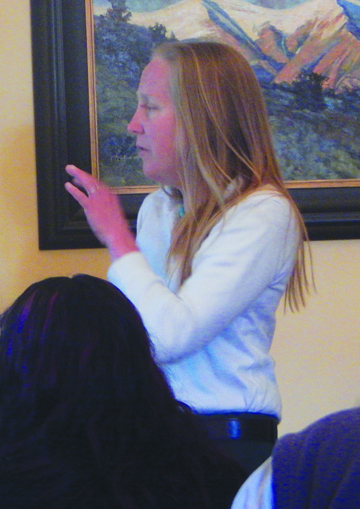URGED learns about Valley forest history

DEL NORTE— Erin Minks, planner with the Rio Grande National Forest, began the Upper Rio Grande Economic Development group’s meeting on Tuesday, April 11 with a presentation on the history of forest land throughout the San Luis Valley. Valley leaders gathered at the Windsor Hotel in Del Norte and enjoyed the presentation over breakfast.
Minks began by highlighting significant time frames throughout the history of the Valley beginning with how communities like South Fork, Del Norte and Creede were before the railroad and before the forests were reserved through an act of congress. Minks painted a picture of the Valley before larger populations of people flooded to the area for the mining boom and how the Indian reservations made up most of the surrounding area before being moved to accommodate the changing industries.
In 1891, a law was passed that allowed the president to designate forest reserves throughout the country, but it wasn’t until 1902 that Theodore Roosevelt created the San Isabel National Forest Reserve in response to requests made by residents in the area to help maintain and protect water resources in the forest surrounding the area. Most of the requests came from cattle ranchers that beginning to populate the area and wanted water resources protected for their livestock.
In 1905, the San Isabel National Forest reserve was joined on the western end of the San Juan Forest Reserve that cradled the San Juan Mountains on both eastern and western sides. This reserve was the result of a study known as the DeBois Report. The report was created by one of the first forestry individuals in the area and highlighted the impacts of livestock on the natural environment. Most of the field work done for the study was completed in 1903 and showed the impacts of both cattle and sheep in the area.
The DeBois Report showed that without proper management of the forest, the land would no longer be useful due to the impacts of livestock in the area and needed to be preserved for future use. Since there were no reservoirs in the Valley at that time, water resources could not be stored and were instead spread out among natural waterways and outlets. The main priority of the early forest personnel was to ensure watershed health by eliminating contamination coming from both livestock and surrounding mining operations that were beginning to take hold in the area.
Mink continued her presentation by introducing an interesting timeline of the creation of the Rio Grande Forest into what it is today. By The end of the presentation, many in the attending crowd were able to get a grasp of how the Forest Service was formed in those early years and the impacts it had on forest health and watershed preservation in the area. Mink finished her presentation by stating that there were several other areas of historical study that could come from the brief history she had just presented and that she would be happy to provide another presentation in the future.



